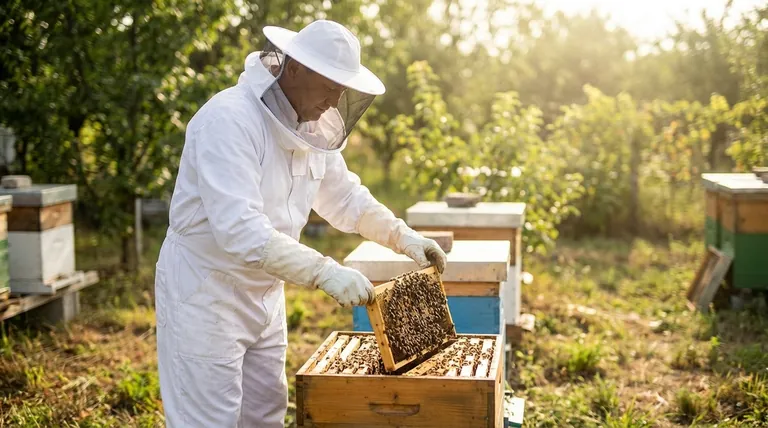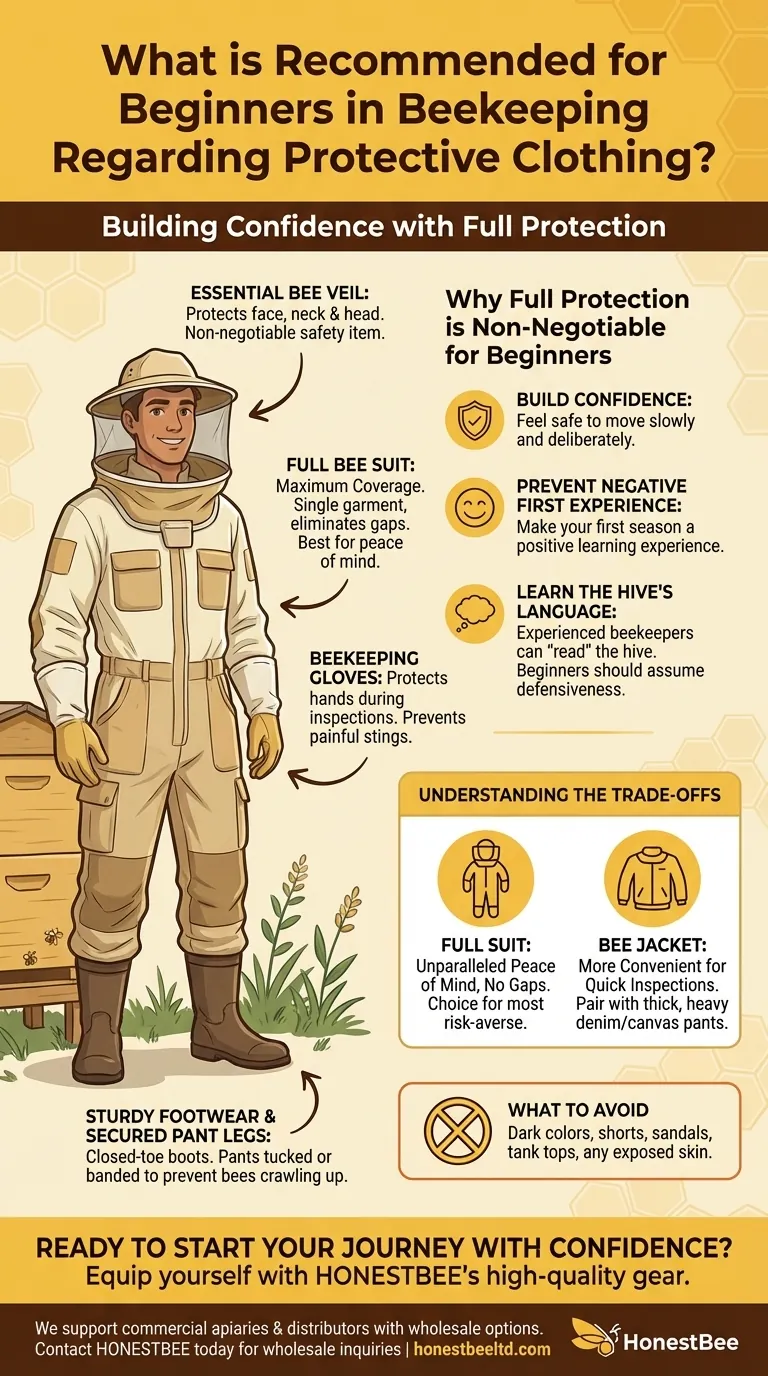For a beginner beekeeper, the recommended protective clothing is a complete setup. You should always start by wearing a proper bee veil, gloves, and either a full bee suit or a protective jacket every time you work with your hives. This approach prioritizes safety and allows you to build confidence without the fear of stings.
Your initial goal isn't just to manage bees; it's to build the confidence to work calmly and effectively. Starting with full protective gear removes the fear of stings, allowing you to focus on learning the craft and the language of the hive.

Why Full Protection is Non-Negotiable for Beginners
As an experienced advisor, I see new beekeepers succeed when they feel safe. Sacrificing a little comfort at the start for a massive gain in confidence is the best trade you can make.
Building Confidence is Your First Priority
Feeling secure allows you to move slowly and deliberately around your bees. Nervous, quick movements can alarm a colony, making an unpleasant experience more likely. A full suit acts as your armor, letting you focus on the bees instead of your own anxiety.
Preventing a Negative First Experience
A significant stinging incident early on can be deeply discouraging. The goal is to make your first season a positive learning experience, and effective protective gear is the single best tool to ensure that happens.
You Haven't Learned to "Read" the Hive Yet
Experienced beekeepers can often assess a colony's mood and know when they can get away with less protection. As a beginner, you do not have this skill yet. Assume every hive is defensive until you have the experience to know otherwise.
The Core Components of Your Protective Gear
Your protective setup consists of several key pieces. While you can mix and match some items, one component is absolutely essential.
The Essential Veil: Protecting Your Face
The single most important piece of gear is the hat and veil. Bee stings are painful, but stings to the face—especially the eyes, nose, and lips—can be dangerous and extremely distressing. Never work a hive without a veil.
The Full Bee Suit: Maximum Coverage
A full bee suit is a single garment that covers you from your ankles to your wrists and includes an integrated or attached veil. It offers the most complete protection by eliminating any gaps between a jacket and pants.
The Bee Jacket: A Popular and Practical Alternative
A bee jacket is a very popular choice that provides protection for your entire upper body and also includes a veil. Beekeepers wear this with their own pants, which must be made of thick material like heavy denim or canvas painter's pants.
Gloves: Protecting Your Hands
Beginners should always wear beekeeping gloves. While they reduce some dexterity, they prevent stings on your hands, which are closest to the bees during an inspection.
Footwear and Pant Legs
Always wear sturdy, closed-toe boots or shoes. To prevent bees from crawling up your legs, tuck your pants into your socks or use elastic boot bands to secure the cuffs tightly around your ankles.
Understanding the Trade-offs
Your primary decision will be between a full suit and a jacket. There is no single "correct" answer; it depends on your personal comfort with risk and your budget.
The Case for a Full Suit
A full suit provides unparalleled peace of mind. There is no risk of a gap opening at your waistline if you bend over. For the most risk-averse beginner, a suit is the superior choice.
The Case for a Jacket
A jacket is often seen as more convenient and less cumbersome for quick inspections. When paired with appropriate, thick pants, it provides excellent protection and is a perfectly valid choice for a beginner.
What to Avoid in Your Clothing Choices
Regardless of your suit or jacket choice, never wear dark colors, as they can appear threatening to bees. Avoid shorts, sandals, tank tops, or any clothing that exposes skin. Ensure your shirt is long enough to stay tucked in if you are not wearing a full suit.
Making the Right Choice for Your First Season
Use this guide to make an informed decision based on your primary goal as you start your beekeeping journey.
- If your primary focus is maximum safety and minimizing anxiety: Invest in a full, light-colored bee suit.
- If you are looking for a balance of protection and convenience: A quality bee jacket paired with thick denim or canvas pants is a solid and effective choice.
- Regardless of your choice: A veil is non-negotiable, and you must always wear closed-toe shoes with your pant legs secured.
The right gear empowers you to stop worrying about stings and start focusing on the fascinating world inside the hive.
Summary Table:
| Protective Gear | Purpose & Key Features | Recommended for Beginners |
|---|---|---|
| Bee Veil | Protects face, neck, and head from stings. Non-negotiable safety item. | Essential |
| Full Bee Suit | Full-body coverage (ankles to wrists). Offers maximum protection and peace of mind. | Highly Recommended |
| Bee Jacket | Upper body protection with a veil. A popular balance of protection and convenience. | Recommended |
| Beekeeping Gloves | Protects hands during hive inspections. Reduces dexterity but prevents painful stings. | Essential |
| Sturdy Footwear | Closed-toe boots or shoes. Prevents stings on feet and ankles. | Essential |
Ready to Start Your Beekeeping Journey with Confidence?
Equip yourself with the right protective gear from the very beginning. HONESTBEE supplies durable, high-quality beekeeping suits, jackets, veils, and gloves designed specifically for safety and comfort.
We support the success of commercial apiaries and beekeeping equipment distributors through our wholesale-focused operations.
Let's discuss your needs and ensure your beekeepers have the best protection available.
Contact HONESTBEE today for wholesale inquiries
Visual Guide

Related Products
- Cotton Beekeeping Suit and Round Hat with Veil Bee Keeper Protective Gear
- White Beekeeping Protective Suit and Hat with Fencing Veil for Beekeepers
- Economy Polyester Beekeeping Jacket with Veil and Hat
- Beekeeping Jacket with Hood and Veil for Beekeepers
- Heavy Duty Cowboy Beekeeper Hat with Visibility Veil Outdoor Professional Beekeeping Protective Gear
People Also Ask
- How should a bee suit be cleaned? Protect Your Investment and Ensure Apiary Safety
- Why is a jacket with a hat veil recommended for beekeepers? Essential Protection for Your Face and Neck
- What are bee suits made of? Choosing the Right Material for Maximum Protection & Comfort
- What are the benefits of a fully ventilated beekeeping suit? Stay Cool and Protected in Hot Climates
- What should be considered regarding the color of beekeeping clothing? Ensure Your Safety and Keep Bees Calm



















